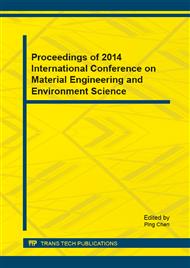[1]
Wang Huachen, Cao Jun, Bian Chang Wan. Transformation TNB24 concentrated machine [J]. Modern mining, 2010, (10): 123 - 124.
Google Scholar
[2]
Liu Aimin, Qin yajuan, Dai Jinghai. Application of ceramic membranes in the production of aluminum hydroxide powder [J]. Development and Application, 2009, (6): 21-23.
Google Scholar
[3]
Liu Moe. Membrane separation technology [M]. Beijing: Chemical Industry Press, (1998).
Google Scholar
[4]
Jiang Hailong, Zhai Zhenshan, Liu Meicheng et al. Ceramic membrane microfiltration technology for black liquor concentration [J]. Paper and Paper, 2005, (3): 68 ~ 70.
Google Scholar
[5]
Lu Lixia, Han Yilong, Xiong Qiang et al. Study on inorganic ceramic membrane microfiltration concentrate conditions of lactobacillus [J]. Food and Fermentation Industries, 2006, 32 (9): 64 ~ 66, 71.
Google Scholar
[6]
Zeng Mengxiang, Li Yuangao, Yan Bin et al. Inorganic ceramic membrane performance liquid resin enrichment process analysis [J]. Xiamen Institute of Technology, 2012, 20 (3): 78 ~ 81.
Google Scholar
[7]
Zhaoliang Wu, YuqiangJi, YananGuo et al. Application of Ceramic Membrane Filtrationto Remove the Solid in Nisin Fermentation Broth [J]. International Journal of Food Engineering, 2008, 4(4): 1~8.
DOI: 10.2202/1556-3758.1192
Google Scholar
[8]
Mohsen Abbasi, Abdolhamid Salahi, Mojtaba Mirfendereskiet al. Desalination and Water Treatment, 2012, (37): 21~30.
Google Scholar
[9]
Wu Jun, Xing Weihong, Xu Nanping. Experimental study on treatment of dyeing Wastewater by inorganic ceramic membrane [J]. Dyes and dyeing, 2004, 8 (4) : 241-243.
Google Scholar
[10]
Zhu Chen, Wang Zhi, He Xilin, Lu Shuqun, Zhu Qixing. Ceramic microfiltration membrane application in research and regenerative properties of the pulp industrial wastewater and recycling [J]. Filtration and separation, 2005, 15 (1): 16 ~ 17.
Google Scholar
[11]
Ma Lin, Qin Guotong. Progress of membrane fouling mechanism and mathematical model [J]. Water Technology, 2007, 6 (6); 1-2.
Google Scholar
[12]
Fu Jiangtao, Wang Rong, Wang Guoqiang. Treatment of dyeing wastewater and reuse engineering application by double membrane [J]. Industrial Water Treatment, 2010, 1 (1); 87 to 89.
Google Scholar



